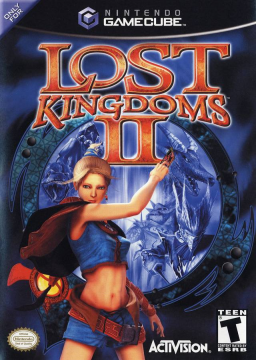In the most basic of interactions, damage is very simple. In Lost Kingdoms II, damage is Attack minus Defense. If an attack of 10 damage hits something with 5 defense, the target will take 5 damage.
Yet there are a number of variables that change how damage works in Lost Kingdoms II, and in the Japanese version, RunE II. We’ll get into these one at a time.
The following are all of the variables that modify attack:
Attack:
Z-Effect:
If the player Z-Effects a card, take the attack value and multiply it by 1.5, rounded down. Only the player can take advantage of this variable. This is the only step in damage calculation that rounds down until the very end. For example: 10 attack becomes 15, and 11 attack becomes 16, not 16.5.
RunE II ONLY
Affinity Level Multiplier:
Take your post-Z-Effect value and multiply it by:
0.90 at 1 star
0.95 at 2 stars
1.00 at 3 stars
1.05 at 4 stars
1.10 at 5 stars
1.15 at 6 stars
1.20 at 7 stars
1.25 at 8 stars.
Take our values from earlier. If using a Wood card at 7 Stars in Wood:
15 becomes 18, and 16 becomes 19.2.
Wizard/Apsaras (WizAps): If Wizard or Apsaras are out, take the post-Z-Effect, post-Affinity-Level, value and multiply it by 1.5.
Wizard and Apsaras both apply this effect, yet they do not stack. Having both cards out will have the same effect as having only one of the two out for this variable. WizAps only applies to allied cards; an enemy WizAps will not apply bonuses to the player, only to enemy creatures, and vice versa.
Take our values from earlier, 10 attack with Z-Effect:
USA/PAL:
15 becomes 22.5, and 16 becomes 24.
RunE II:
18 becomes 27, and 19.2 becomes 28.8.
Dryad, Undine, Gnome, Salamander (DUGS):
Take the post-Z-Effect, post-Affinity-Level, post-WizAps value, and:
If the creature is Fire, multiply the attack value by 2.0 if Salamander is out, and by 0.5 if Undine is out.
If the creature is Water, multiply the attack value by 2.0 if Undine is out, and by 0.5 if Gnome is out.
If the creature is Earth, multiply the attack value by 2.0 if Gnome is out, and by 0.5 if Dryad is out.
If the creature is Wood, multiply the attack value by 2.0 if Dryad is out, and by 0.5 if Salamander is out.
Note that these are ANDs. If the creature is Wood and both Dryad and Salamander are out, the multiplier is set to 1.0.
These creatures modify the attack value of any creature in an area around them, regardless of alignment, ally or enemy alike.
For example, take our values from earlier, a Wood card with 10 attack, with Z-Effect, and WizAPS, at 7 Wood Affinity. With Dryad out, then with Salamander out:
USA/PAL:
Dryad: 22.5 becomes 45, and 24 becomes 48.
Salamander: 22.5 becomes 11.25, and 24 becomes 12.
RunE II:
Dryad: 27 becomes 54, and 28.8 becomes 57.6.
Salamander: 27 becomes 13.5, and 28.8 becomes 14.4.
-
Coal Treant and Dark Treant (CDT):
Take the post-Z-Effect, post-Affinity-Level, post-WizAps value, post- DUGS value, and:
If the creature is Fire or Water, multiply the attack value by 0.5 if Coal Treant is out.
If the creature is Earth or Wood, multiply the attack value of 0.5 if Dark Treant is out.
Similarly to DUGS, these creatures modify the attack value of any creature in an area around them, regardless of alignment, ally or enemy alike.
For example, take our values from earlier, a Wood card with 10 attack, with Z-Effect, and WizAPS, corresponding DUGS, at 7 Wood Affinity. With Dryad out, then with Salamander out. Now, with Dark Treant:
USA/PAL:
Dryad: 45 becomes 22.5, and 48 becomes 24.
Salamander: 11.25 becomes 5.625, and 12 becomes 6.
RunE II:
Dryad: 54 becomes 27, and 57.6 becomes 28.8.
Salamander: 13.5 becomes 6.75, and 28.8 becomes 7.2.
That concludes the Attack Portion, now onto Defense:
Defense:
This value then has the defense of the opposing creature subtracted from it.
32 cards in Lost Kingdoms II pierce defense naturally, and Cyclops allows all allied creatures to ignore defense. Six creatures in Lost Kingdoms II have True Defense, which can not be pierced.
For example, take our values from earlier, a Wood card with 10 attack, with Z-Effect, and WizAPS, corresponding DUGS, at 7 Wood Affinity. With Dark Treant and Dryad out, then with Dark Treant and Salamander out, against a creature with 2 defense:
USA/PAL:
Dryad: 22.5 minus 2 is 20.5, 24 minus 2 is 22.
Salamander: 5.625 minus 2 is 3.625, 6 minus 2 is 4.
RunE II:
Dryad: 27 minus 2 is 25, 28.8 minus 2 is 26.8.
Salamander: 6.75 minus 2 is 4.75, 7.2 minus 2 is 5.2.
Treant and Apsaras (TreAps):
Treant and Apsaras add a flat 25 defense to allied creatures in the area. For example, a creature with 13 defense would then have 38 defense with an allied Treant or Apsaras out.
Elemental Matchup:
This is the final stage of damage calculation in Lost Kingdoms II and RunE II. This multiplier applies after defense has been removed from the value in question. After this, damage rounds down, unless it would be below 1, in which case it rounds up.
There are five states that the Elemental Matchup variable can be in. These are referred to as Disadvantage, Mech, Base, Neutral, and Advantage. The naming convention is a bit strange, as Neutral is an element in this game and has a bonus instead of being truly “neutral,” but stick with me.
Disadvantage adds a multiplier of 0.6.
Mech adds a multiplier of 0.8.
Base adds a multiplier of 1.0.
Neutral adds a multiplier of 1.2.
Advantage adds a multiplier of 1.5.
The four main elements, Fire, Water, Earth, and Wood, interact with each other in that series, or order: Fire has Disadvantage against Water,
Water has Disadvantage against Earth,
Earth has Disadvantage against Wood,
Wood has Disadvantage against Fire.
The reverse is also true:
Fire has Advantage against Wood,
Wood has Advantage against Earth,
Earth has Advantage against Water,
Water has Advantage against Fire.
Neutral deals slightly increased damage to Fire, Water, Earth, and Wood.
Fire, Water, Earth, and Wood deal base damage to Neutral.
Mech deals base damage to Fire, Water, Earth, and Wood.
Fire, Water, Earth, and Wood deal slightly reduced damage to Mech.
Elements deal Base damage to themselves.
Fire and Earth deal Base Damage to each other.
Water and Wood deal Base damage to each other.
Neutral and Mech deal Base damage to each other.
The card or creature Larval Fly forces all matchup to Base, regardless of alignment; ally or enemy.
The card or creature Beelzebub forces all matchup to Advantage, regardless of alignment; ally or enemy.
Mad Reverser flips these interactions on their heads:
Fire has Disadvantage against Wood,
Wood has Disadvantage against Earth,
Earth has Disadvantage against Water,
Water has Disadvantage against Fire.
The reverse is also true:
Fire has Advantage against Water,
Water has Advantage against Earth,
Earth has Advantage against Wood,
Wood has Advantage against Fire.
Neutral deals base damage to Fire, Water, Earth, and Wood.
Fire, Water, Earth, and Wood deal slightly increased damage to Neutral.
Mech deals slightly reduced damage to Fire, Water, Earth, and Wood.
Fire, Water, Earth, and Wood base damage to Mech.
Larval Fly and Beelzebub override Mad Reverser.
With all this taken in, let’s do a few fresh examples:
11 attack, Z-Effect, WizAps, 2.0 DUGS, Cyclops (to pierce defense), Advantage:
11 x 1.5, round down to 16
16 x 1.5 = 24
24 x 2.0 = 48
Ignore Defense
48 x 1.5 = 72.
We can also use this to reduce damage drastically.
Versus Tara with 20 base defense, 200 attack, 0.5 DUGS, CDT, Treant, Disadvantage:
200 x 0.5 = 100
100 x 0.5 = 50
50 - (20 + 25) = 5
5 x 0.6 = 3
There will be occasions where you deal one more damage than you expect because the formula only rounds down after Z-Effect and then once again at the very end. Keep an eye on decimals. As well, RunE II appears to have a fairly prevalent error with floating points, and you will randomly deal one less damage than you expect to due to a floating point error that is tied to the Affinity Level multiplier. Best of luck.
(((Base Attack x Z-Effect) x [Affinity Bonus in RunE II ONLY] x Wizard OR Apsaras x Dryad and Undine and Gnome and Salamander x Coal Treant and Dark Treant) - Defense) x Element Match-up





